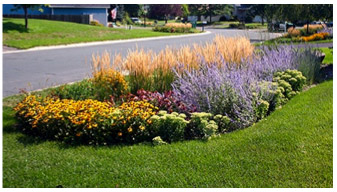
Two of the most common and most easily implemented best management practices for stormwater control on private property are rain barrels and rain gardens.
Rain barrels are designed to keep rainwater out of storm drains and sewers. Connected to your home's downspout, the rain barrel collects stormwater during each rainfall. Residential rain barrels come in a variety of colors, shapes and materials and range in size from a 30-gallon capacity up to about 150 gallons. What size and how many a homeowner may need to adequately capture rainfall depends on the size of the home’s roof size and the average rainfall in your geographic area.
In southwestern Pennsylvania, an average rainfall is one-quarter inch, while the average roof size is about 1,000 square feet. That equates to about 150 gallons of stormwater flowing from the rooftop during each rainfall. Over a year—our region averages about 37.5 inches of rainfall annually—that total accumulates to about 22,500 gallons of stormwater per house.
Rain barrels are a practical, low-cost, lot-level solution for helping to control stormwater, which can cause sewage overflows and pollution of our rivers and streams. During dry weather, a hose connected to the barrel allows the high quality rainwater, devoid of minerals, chlorine and other chemicals, to seep out to water your garden and replenish the groundwater table. Rain barrels can help to direct stormwater away from the foundation of your home and reduce your water and sewer bills.
 Rain barrels can be relatively inconspicuous when placed near a shrub or bush.
Rain barrels can be relatively inconspicuous when placed near a shrub or bush.
Many rain barrels are constructed of UV-stabilized Low Density Polyethylene (LDPE) to prevent warping, fading or cracks. The barrels are generally designed to retain leaves, twigs and roofing materials without clogging the barrel, while also being mosquito-safe.
Generally, rain barrels require maintenance by the homeowner to drain after each rain event to assure there is capacity for the next rainfall. Rain barrels should be disconnected during winter months to prevent freezing.
In 2004, 3RWW completed a rain barrel project with the Nine Mile Run Watershed Association to install 500 rain barrels in the Nine Mile Run watershed. This project was designed to be a public education tool and a model to expand the use of rain barrels throughout Allegheny County.
On average, rain barrels cost anywhere between $70 and $300 and can be purchased online from multiple sources or locally through the Nine Mile Run Watershed Association's StormWorks program.
Rain gardens, when planned and installed correctly, can be a very effective as well as visually appealing, stormwater management tool for homeowners. If you have noticed standing water on your lawn, detected soil erosion or need to move stormwater away from your home’s foundation, a rain garden may be right for you. Rain gardens help to manage the stormwater that falls on your property thereby preventing it from entering and overwhelming the storm sewer system. They collect and hold rainwater for a brief time (less than 48 hours) slowly releasing it through the soil or allowing plants to soak it up.
Determining the location, size and slope of your rain garden are all key to the success of this green solution. Most rain gardens are between four and eight inches deep in order to provide enough capacity to handle the average rainfall. If the rain garden is too shallow, it needs to be very large and if it’s too deep, it might take too long to drain and result in standing water and mosquito breeding. To improve drainage, especially if the soil has a high clay content common in Southwestern Pennsylvania, you may need to add organic matter to the soil, which will help to lighten the clay and improve drainage, making it better for planting.
 Rain gardens can be very low maintenance, but very visually appealing.
Rain gardens can be very low maintenance, but very visually appealing.
Choose flowers, shrubs and trees native to our region, such as Bee Balm, Tall Sunflowers, Wild Geraniums, Blue-Eyed Grass, Wild Hydrangea and the Common Elderberry. These plants can tolerate short intervals of standing water or drought, have deep roots that let water soak into the soil, and don't require fertilizers or other chemicals.
Spring and fall are the best times to start your garden. In spring, the soil is easier to dig and the rainy weather means less initial watering. Perennials often do best when planted in fall when they have sent all of their energy to their roots for winter.
See our RainWays tool for steps in planning your own rain garden and links to experts if you want assistance in installing on your property.